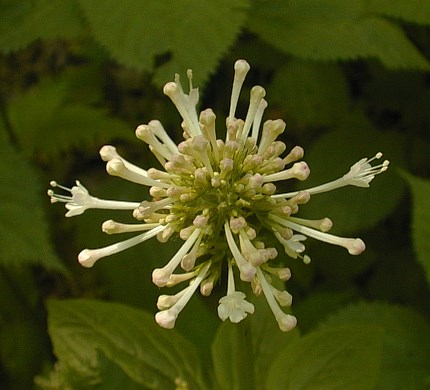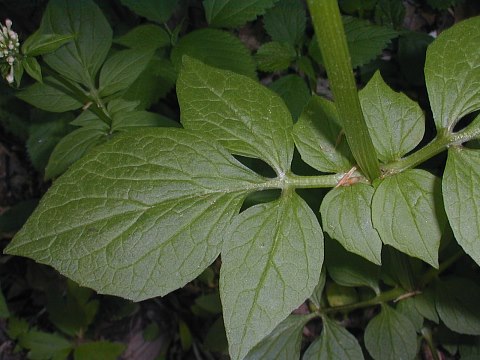Description: This perennial wildflower is 1½–3' tall and unbranched or sparingly branched. The stout central stem is erect, medium green, hairless, and terete. Basal leaves are usually cordate or oval-cordate with long petioles; sometimes they are odd-pinnate with 2 small lateral leaflets and a large terminal leaflet. The cauline leaves occur in opposite pairs along the stem and they are odd-pinnate with 3-7 leaflets. Each cauline leaf is up to 8" long and 4" across. The leaflets are more or less ovate in shape; the terminal leaflet is larger than than the lateral leaflets. The leaflets are medium green, hairless, and smooth to slightly dentate along their margins. Each cauline leaf is sessile at the base, or it has a short petiole. The central stem terminates in a short dense panicle of flowers that becomes more elongated with age. Much smaller panicles of flowers may develop from the axils of the upper leaves. Each flower has a slender funnelform corolla with 5 spreading lobes; this corolla is white to light pink and about ½–¾" long. Exerted from each corolla, there are 3 stamens and a slender style. At the base of the flower, there is a green calyx that is much shorter than the corolla.

The blooming
period occurs from late spring to early summer and lasts about a month.
Each flower has a single-celled ovary that produces a single achene.
Each achene has a tuft of plume-like hairs; the achenes are distributed
in part by the wind. The root system is fibrous and its produces
occasional rhizomes or stolons. Sometimes small colonies of plants
develop from the rhizomes or stolons.
Cultivation:
The preference is light shade to partial sun, consistently moist
conditions, and fertile soil with abundant organic matter. The foliage
is rarely bothered by disease or insects.
Range & Habitat:
The native Large-Flowered Valerian is occasional in extreme
east-central,
southeast, and southern Illinois; elsewhere in the state, it is largely
absent (see Distribution
Map). Illinois lies at the western range-limit for this
species. Habitats include floodplain woodlands along streams or rivers,
shaded ravines, and bottoms of rocky canyons. This species is found in
high quality habitats that are moist and shady.

Faunal
Associations:
Information about floral-faunal relationships for this species is very
limited. The long slender corollas suggests that the flowers are
pollinated by bumblebees, butterflies, Sphinx moths, and possibly
hummingbirds. The nectar of the flowers is inaccessible to most insects
with short mouthparts.
Photographic Location:
The wooded bottom of a sandstone canyon at The Portland Arch in
west-central Indiana. In the flowerhead close-up, most of the flowers
are
still in the bud stage.
Comments:
This is the showiest Valeriana sp. in Illinois. Its
flowers exceed ½" in length, while the flowers of other native and
naturalized Valeriana spp. are less than ½" in
length. Large-Flowered Valerian should be cultivated more often.
Sometimes, this species is called Pink-Flowered Valerian.